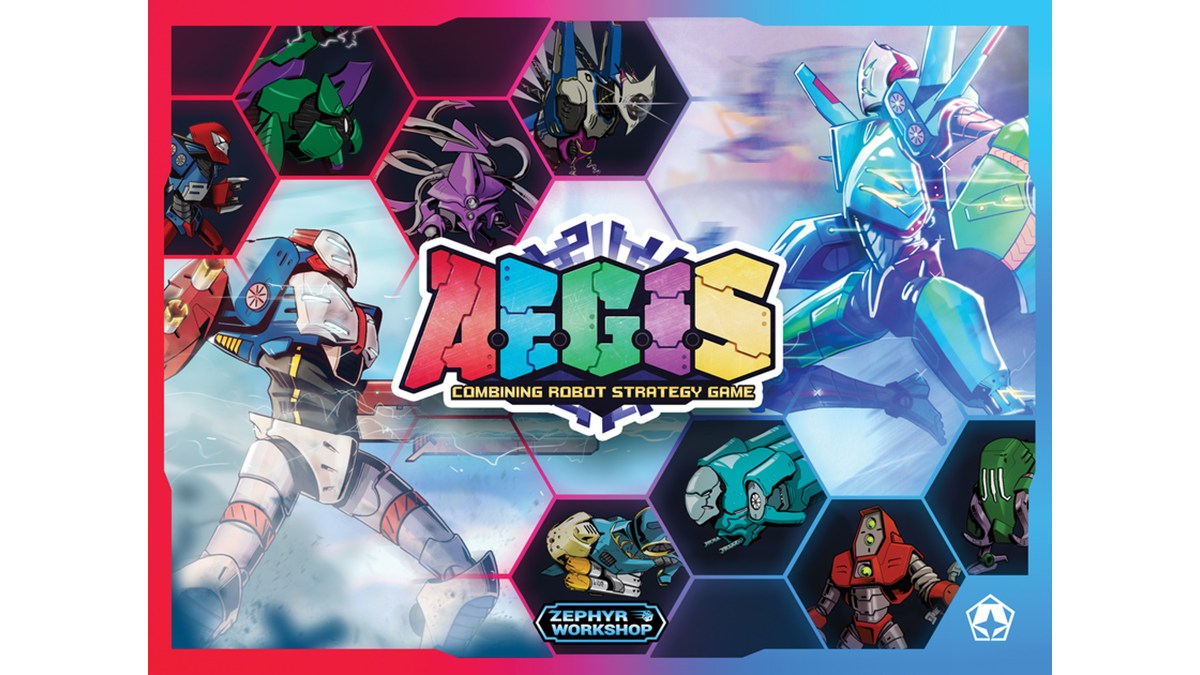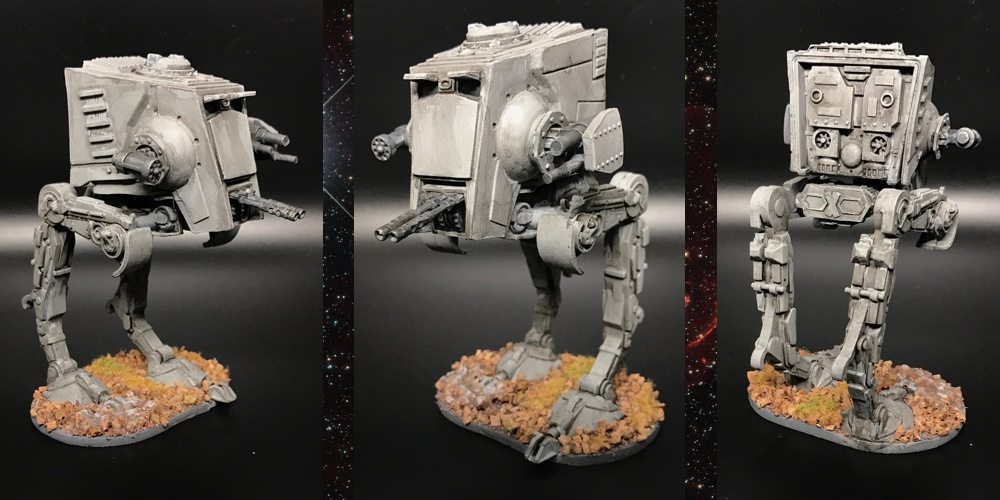Are you ready for some good old fashion robot bashing, smashing, and clashing? In A.E.G.I.S., not only do you get to battle it out with your team of robots, but you can also combine robots into stronger, faster fighting machines!
What Is A.E.G.I.S.?
A.E.G.I.S. is a 2-4 player tactical combat game where you battle head-to-head, or as teams, until one side is victorious. There are no victory points or objectives. This is a straightforward combat game, but with a lot of options. Depending on the number of players, gameplay is 30–120 minutes, and the recommended age is 14+. While I have only played with adults, I believe that the mechanics and theme make A.E.G.I.S. accessible to a slightly younger age. A.E.G.I.S. is published by Zephyr Workshop, and MSRP’s for $49.99. You can check with your friendly local game store to see if they have it or buy it directly from Zephyr Workshop.
A.E.G.I.S. Components
When you open a box of A.E.G.I.S., this is what you’ll see:
- 1 Rulebook
- 1 Double-sided game board
- 28 Cardboard terrain tiles (in various sizes)
- 100 Cardboard robot standees
- 13 Double-sided energy trackers
- 44 Damage/Drain counters
- 18 Buff/Debuff counters
- 4 Restrain/Disarm counters
- 3 Cloaking counters
- 1 Rogue decoy
- 30 Plastic standee holders
- 100 Robot cards
- 13 Commander cards
- 10 Colored dice
- 25 Colored standee bases
- 1 Custom box insert

Let’s start with the focus of the game – the robots. A.E.G.I.S. has 100 robot standees. That is a lot of different robots and even more team combinations. Normally, in a combat game, I prefer miniatures to standees, but in the case of A.E.G.I.S., I think the standees are perfect for several reasons. First, with 100 different robots, it would be difficult to easily identify one robot miniature from another without each one having a very distinct artistic style and/or paint job. However, on the standee, the robot image corresponds to its card for easy identification. Additionally, each standee lists that bot’s basic stats directly on them (movement, health, etc.) for everyone to see without needing to reference its card. Secondly, providing standees allows all of A.E.G.I.S.‘s components to be stored in a medium-sized box. And lastly, each standee is clearly numbered and corresponds with its card, making it easy to find them if you keep them organized numerically. In my opinion, I think using standees was the correct choice in this situation.

The double-sided board has a predetermined setup for a 2-player game on one side and a 3- or 4-player game on the other. It is divided into a hex grid and has some nice artistic touches like trees and terrain to give it some flavor. Although the board shows locations where terrain tiles can be placed, you are welcome to set up the tiles wherever you like, allowing for different setups and scenarios each game.
The energy tracker boards represent the available commanders in the game. Each board functions the same, but with unique artwork.

The last components I’ll discuss are the dice and standee bases. These are both translucent and come in five different colors representative of the different robot classes (red, green, blue, yellow, and purple). The standee bases make it clear which robots belong to which team.
Overall, the quality of the cardboard standees, tokens and game board are great with good thickness and durability. The cards are a little oversized, making them easy to read and handle on the table. The artwork is manga style with unique artwork for each robot and commander card. And best, of all, the box comes with a custom insert to easily store all the components when you are done playing.
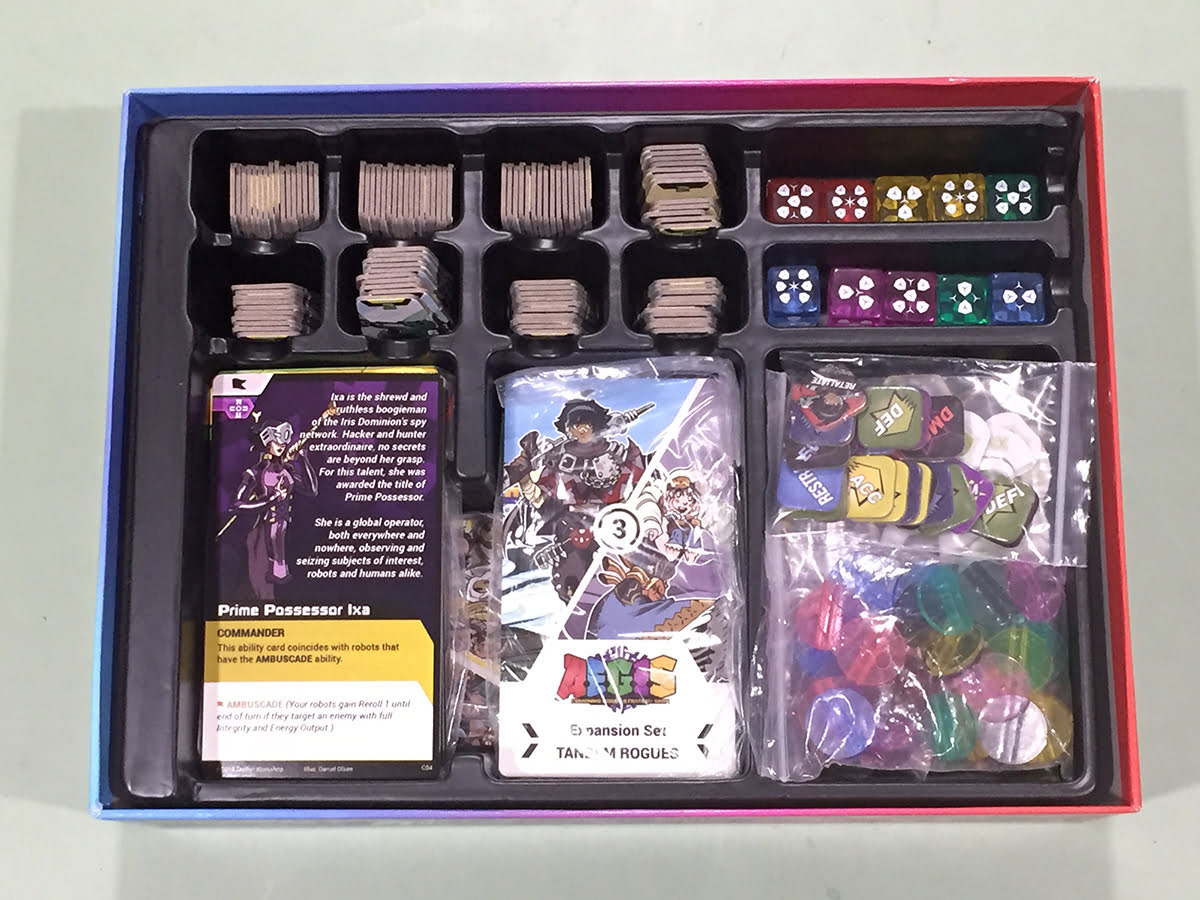
How to Play A.E.G.I.S.
The World
There is a backstory and lore to A.E.G.I.S. that provides fun flavor and story to the overall theme of the game. Without getting into details, the world of A.E.G.I.S. is at war and is separated into five factions. Having recently discovered ancient robots, these factions battle each other for control of the world. Each player will play as a commander of one of these nations, bringing an army of five robots to each skirmish.
The robots themselves are divided into five categories:
- A-Class: Aggressive attackers
- E-Class: Swift scouts
- G-Class: Sturdy tanks
- I-Class: Tricky technicians
- S-Class: Helpful backliners
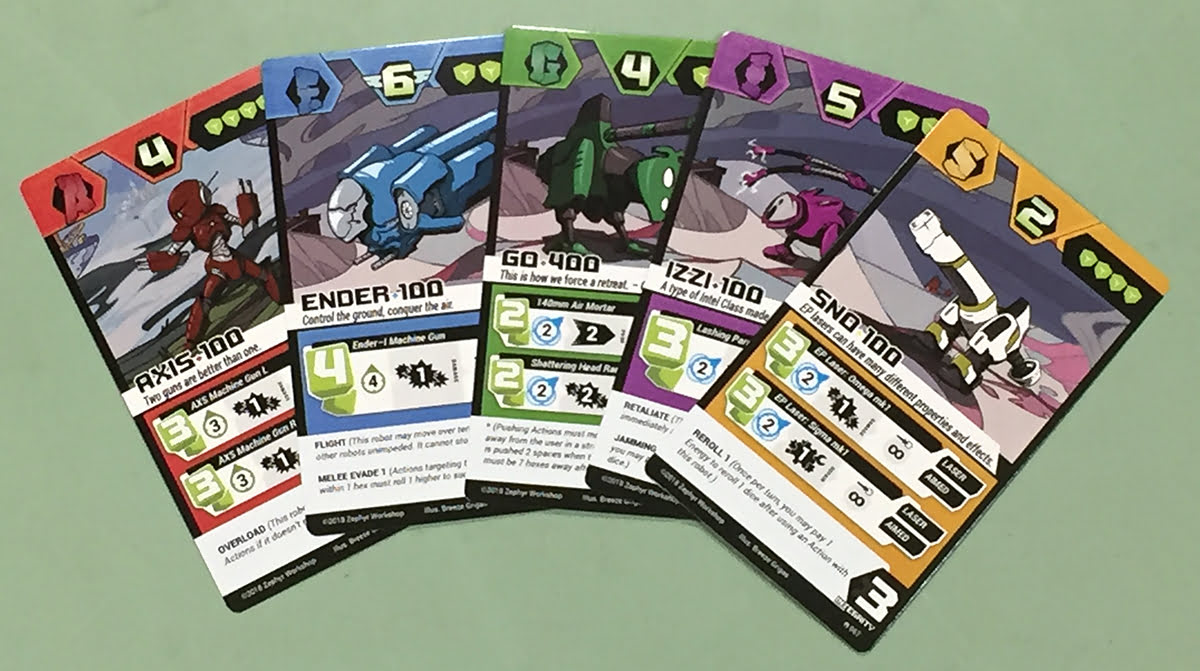
There are also five robot levels in the game
- Level 1: Basic Robots. These consist of your starting bots and belong to one of the class types – A, E, G, I, or S.
- Level 2: Duo-Class Robots are formed when two robots of different classes combine.
- Level 3: Trio-Class Robots are created by adding a third robot to a level 2 bot.
- Level 4: Quadra-Class Robots comprise four robots.
- Level 5: A.E.G.I.S. Class Robots. This is your Voltron-like megabot and is the most difficult one to form since it must be composed of one robot from every class type.

Anatomy of a Robot Card
All the information for each bot is conveniently located on its card, and includes:
- Class: The class is identified by the letter or combination of letters associated with the robot’s class as shown in the upper left corner of the card.
- Movement: The number of spaces the robot can move in a single turn and whether it can fly. This is located center top of the card.
- Energy: The amount of energy the bot generates for its team. This is located in the upper right corner of the card.
- Name: Each bot has a distinctive name, ‘ARK 150’ for instance.
- Integrity: This is the robot’s health and is shown in the lower right corner of the card. When a bot’s integrity reaches zero, it is eliminated from the game.
- Abilities: Some bots might have a passive ability that affects how it plays. If it has an ability, it will be listed at the bottom of the card.
- Actions: Each robot has one or more actions that might be an attack or skill that can be used on other robots. These actions are listed at the bottom of the card.
- Faction: Some robots will be aligned with one of the five factions, which will be identified by that faction’s symbol in the upper left corner of the card, beneath its class.
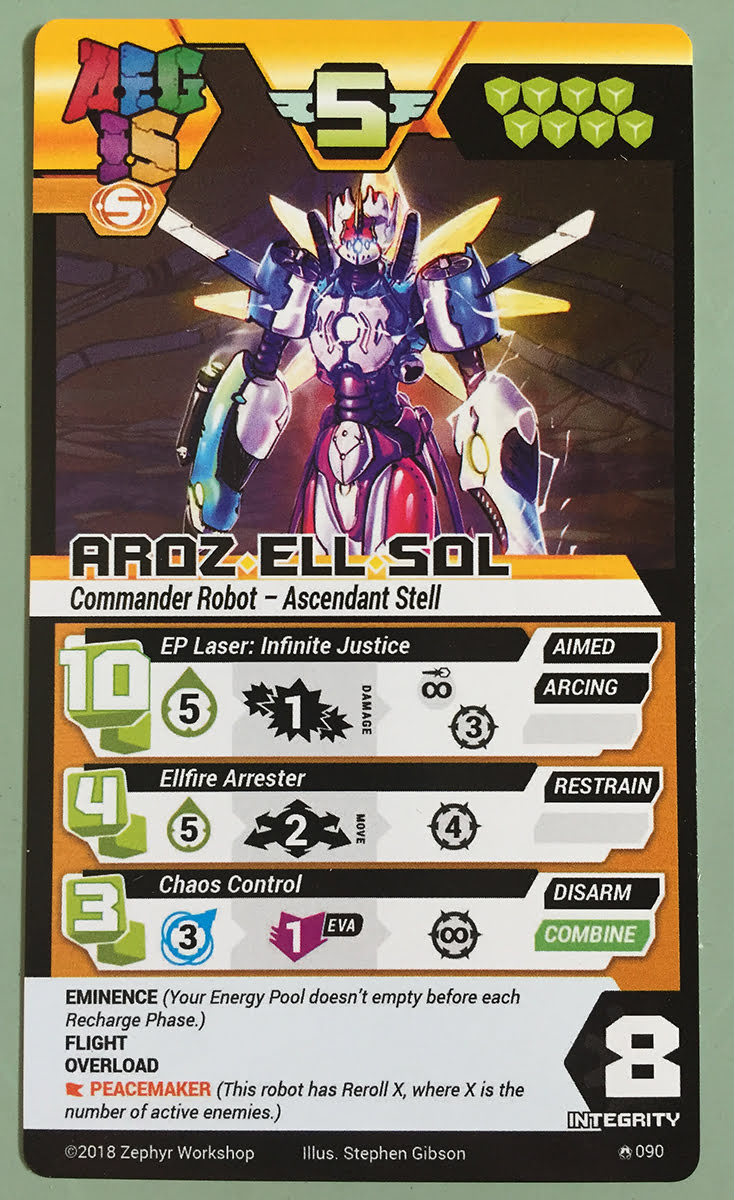
Creating Your Team
Before beginning, each player builds an army of five robots. There are some criteria that must be followed however:
- Your team can only belong to a single faction. Fortunately, most of the robots do not have faction symbols so this criteria isn’t that limiting.
- You cannot have any duplicate robots on your team.
- You can have only one commander robot on your team although you don’t need any commanders if you want.
- Lastly, in addition to your starting five robots, you may have a Combine Pool of up to five robots. Per its name, the Combine Pool is made up of robots that are Level 2 through 5.

Board Setup
Layout the board and place up to 10 pieces of terrain on the board. Then each player rolls a die. The player with the higher roll goes first and deploys their team within their starting zone, followed by the opposing player, who does the same.
Player Turn
The first player will take their entire turn, and then the next player will go. On your turn, determine your total energy output by adding up all the energy produced by your active robots and mark it on your energy tracker. You can then use that energy to move your robots, trigger actions, and/or combine robots. Note that each robot can only activate once per turn, but you do not need to activate every robot each turn. Energy is a limited resource and how you use it is a critical part of your strategy.

Movement typically costs one energy to move one space unless the robot’s card states otherwise. For instance, some more maneuverable bots can move several spaces for a single energy. Unless a robot has flight, it cannot move through terrain. Movement must occur before taking an action or combining robots.
Energy can also be used to trigger actions. The energy cost for an action is listed on the card. Actions include:
- Damage: If successful, this reduces the target robot’s integrity.
- Repair: This action allows you to heal damaged robots up to their maximum integrity.
- Energy Drain: This action reduces the amount of energy a robot produces, thus reducing the overall energy your opponent will have to work with.
- Push / Pull: As it states, this ability allows you to direct a robot away or towards you. Robots pushed off the board are destroyed while robots pushed into other bots or terrain take damage.
- Move: Unlike the Push / Pull ability, Move allows you to move robots in any direction; however, they cannot be moved off the board, nor do they take damage if moved into another robot or terrain.
- Buff / Debuff: This action allows you increase / decrease a specific ability of the target bot. For instance, you could buff a friendly unit, increasing its damage output.
Lastly, you may spend energy on combining robots. Only two robots may combine at a time and they must be adjacent to each other. Pay the cost of the robot that they are combining into and replace the two robot standees with the new combined robot standee. Note that once you combine robots, they cannot deconstruct back into the original bots.

If you have unused energy at the end of your turn, it can be used for defensive abilities during an opponent’s turn. At the beginning of your next turn, your energy will replenish to its maximum level, based on what robots you still have alive at the start of that turn.
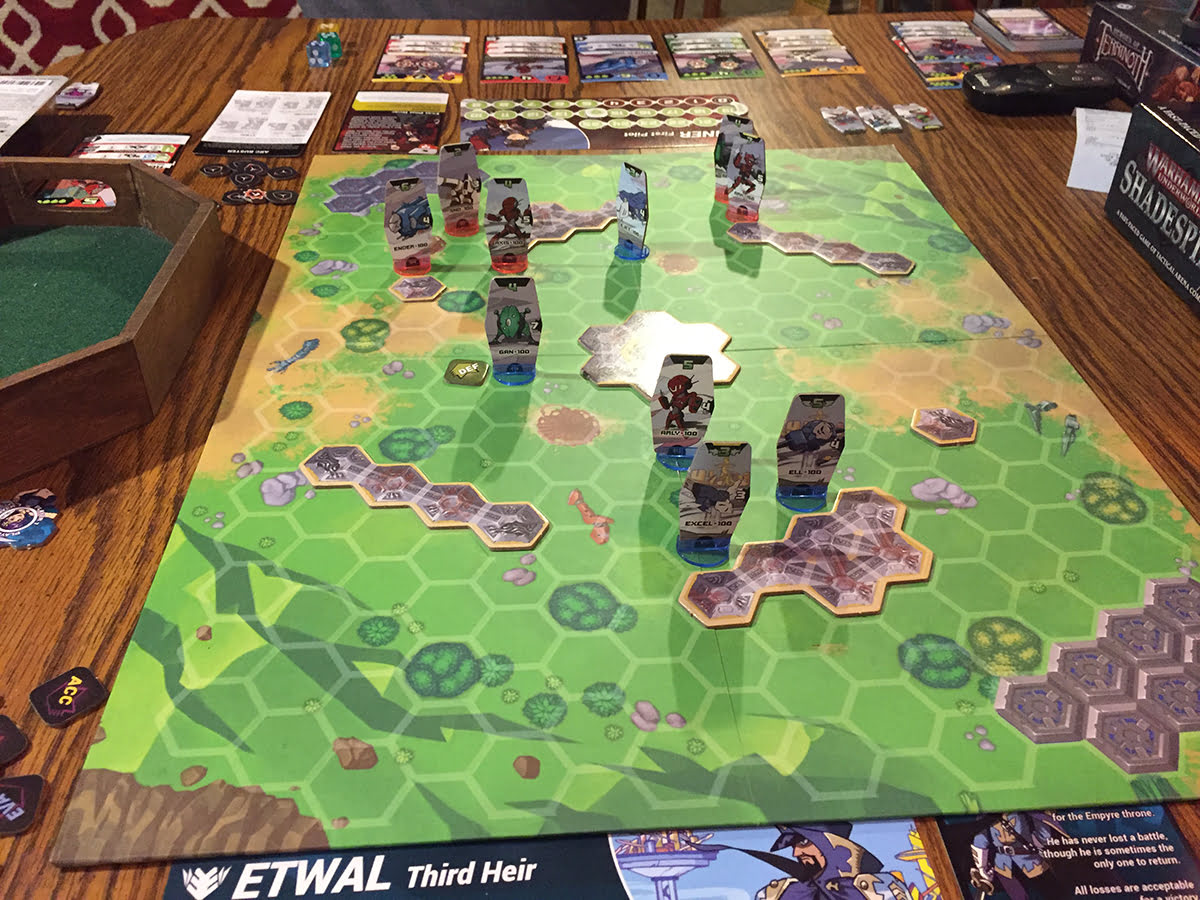
Game End
Battles rage on until one of the following conditions are met:
- One army is annihilated;
- One army cannot produce at least five energy at the start of its turn; or
- One army is unable to deal damage, drain energy, push or pull the opponent, and so they retreat.
Why You Should Play A.E.G.I.S.
A.E.G.I.S. is a fun, quick skirmish game with a great theme, inspired by shows like Voltron and Robotech. At its core, the game is straightforward, with easy to understand mechanics, making it accessible to entry level players. In fact, the publisher provided ten preconstructed decks that allow players to immediately jump into the game without having to build their own teams. The decks are ordered in a way that introduces players to new abilities and strategies progressively. Additionally, the punch boards with the robot standees were manufactured so that the first ten standees are for deck 1, the next ten for deck 2 and so on, making it even easier to open the box and quickly start playing without needing to punch and organize every component.
All that being said, A.E.G.I.S. also offers the experienced player a lot of complexity in its gameplay. The sheer number of robots available allows you to try different team combinations every play, searching for the best combinations of abilities and actions. This, along with the variable board layout, makes A.E.G.I.S. extremely customizable and replayable. Every game provides a new challenge and strategy as to how to best deploy your team and overrun your opponent. In fact, whether or not to combine your robots and level up adds an additional layer to the overall strategy. While higher level bots tend to be better, combining robots typically reduces your overall energy amount as well as taking you one step closer to defeat by having fewer bots on the board. All of these tactical decisions make A.E.G.I.S. a fun challenge to any level of gamer.
And if all that weren’t enough, in addition to the standard game mode, the rulebook lists several other ways to play the game. The first is called Machine Chess, which plays similarly to the standard mode except opponents alternate turns, activating a single robot at a time until all robots have activated. Then everyone’s energy pools replenish and a new round starts. I like this variant as it is more inline with similar combat games and doesn’t leave one player open to several attacks before getting a turn.
Point Control is another version in which players each have a starting team of 8 robots but the victor is determined by the player who reaches 14 points first. Points are earned by destroying enemy robots, controlling certain areas of the board, or combining into a level 4 or 5 bot.
The next option is Combine Rondo, which allows players to begin the game with combined robots instead of all level 1 bots. Each player gets 9 Unite Points to build their team. A robot’s cost is associated with its level. For example, you could build a team of a level 4 robot, a level 3 robot, and two level 1 robots. Besides that, the game is played the same as the standard mode and robots can still combine into higher level ones.
Lastly, there is Draft Mode, which is meant for higher player counts of 4 or 6 (to play 6 players, you would need to purchase the 6-player battle mat). First, shuffle all the combined robot cards (Levels 2-5) and deal five cards to each player. Then shuffle the basic robot cards (Level 1) and deal ten cards to each player. Players then pick one card from their basic robot cards and pass the rest to the left. This continues until each player has ten basic robot cards from which to build a starting team of five bots. This mode ignores faction rules and commander names.
As you can see, A.E.G.I.S. offers a lot of different game modes in the core box. That combined with the solid component quality, fun theme, and strategic gameplay, makes A.E.G.I.S. a keeper for me.
![]() To subscribe to GeekDad’s tabletop gaming coverage, please copy this link and add it to your RSS reader.
To subscribe to GeekDad’s tabletop gaming coverage, please copy this link and add it to your RSS reader.
Click here to see all our tabletop game reviews.
Disclosure: GeekDad received a copy of this game for review purposes.
